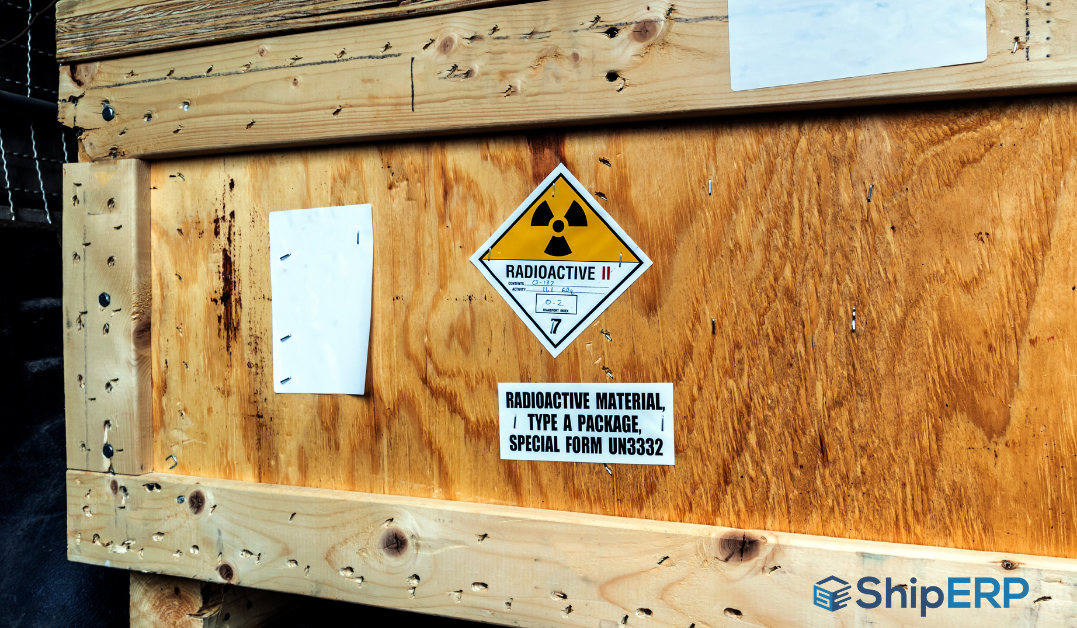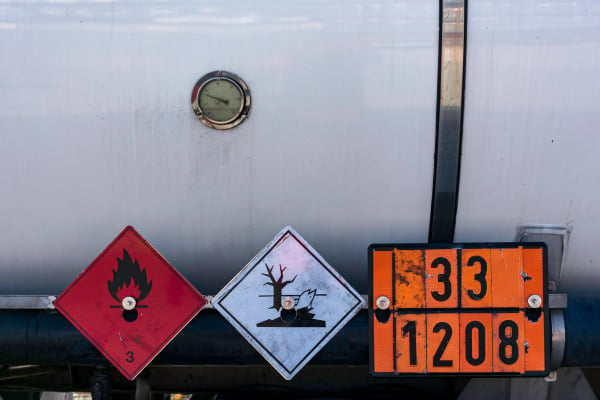
How Do Major Carriers Conduct Dangerous Goods Shipping?
Let's discuss all there is to know about dangerous goods shipping and how major carriers conduct this execute it regularly.
Dangerous goods are hazardous objects or materials that can pose potential risks to human health and safety, the environment, and more. You must ensure that dangerous goods are shipped with care and caution.
Dangerous goods shipping is a complicated process surrounded by a ton of regulations. Major carriers such as FedEx, USPS, UPS, and DHL have to conduct dangerous goods shipping every day.
What is considered as dangerous goods?
Dangerous goods consist of items/substances that can pose a risk to health, safety, property, or the environment if not packaged properly. In total, there are nine groups of dangerous goods, and shippers should understand each one to ensure they are abiding by the rules and regulations.
How are dangerous goods identified and labeled?
There are nine classes dedicated to helping identify dangerous goods. The nine categories include:
Class 1. Explosive Substances and Articles.
This includes objects such as fireworks, flares, blasting caps, igniters, rockets, airbag modules, or seatbelt pre-tensioners. Regulations exist for this category to prevent hazardous amounts of heat, light, gas, or smoke that can harm individuals, the environment, or property.
Class 2. Gases.
This category includes substances with a vapor pressure of 300kPa or more. Examples of gases in the class are aerosols, fire extinguishers, lighters, refrigerant gases, hydrocarbon gas-powered devices, and more.
The subcategories for this class include:
- 2.1 Flammable Gas. This includes camping gas or aerosols, including spray deodorant, spray paint, hairspray, etc.
- 2.2 Non-flammable Gas. This category includes compressed oxygen, nitrous oxide (also known as laughing gas), or compressed carbon dioxide cylinders.
- 2.3 Toxic Gas
Class 3. Flammable Liquids.
This class consists of liquids, liquid mixtures, or liquids containing solids in solutions that give off flammable vapors. Regulations exist for this class to prevent hazards caused by the substances' volatility, combustibility, and ability to cause severe conflagrations.
Examples of flammable liquids include acetone, adhesives, paints, alcohols, perfume products, gasoline, diesel fuel, and more.
Class 4. Flammable Solids.
This class consists of materials that can easily combust during transport due to friction or reactive substances. Regulations exist for this class to prevent serious hazards from occurring due to their combustibility.
Examples of flammable solids include alkali metals, metal powders, aluminum phosphide, matches, sulfur, and more.
The subcategories for this class include:
- 4.2 Substances liable to spontaneous combustion
- 4.3 Substances that expends flammable gases when in water
Class 5. Oxidizers, Organic Peroxides.
Oxidizers are substances that can cause combustion due to yielding oxygen, which causes other materials to combust. Organic peroxides tend to have inconsistent thermals and can release heat when going through exothermic autocatalytic decomposition.
Examples of this class include chemical oxygen generators, fertilizer, hydrogen peroxide for hair bleaching, nitrates, etc.
Class 6. Toxic Substances; Infectious Substances.
Toxic substances can cause death or serious injury to human health. Infectious substances may contain pathogens that can bring disease and sickness to human health. Regulations exist for this class because they can harm health and wellness.
Examples of substances in the category include medical waste, biological cultures, tear gas substances, dyes, alkaloids, acids, etc.
Class 7. Radioactive Material.
This class consists of material that contains radionuclides where both activity concentration and total activity surpasses predefined values. Regulations exist for this class because these substances can emit radiation which is a severe health risk.
Examples of substances in this class include medical isotopes, yellowcake, density gauges, mixed fission products, enriched uranium, etc.
Class 8. Corrosives.
This class consists of substances where chemical actions degrade or disintegrate other materials when in touch. Regulations exist for this class due to their ability to cause severe damage to living tissue or materials.
Examples of substances in this class include acids, batteries, battery fluid, fuel cell cartridges, etc.
Class 9. Miscellaneous Dangerous Goods.
This class consists of substances/articles that present a hazard during shipping that isn't covered by the previous classes.
Examples of miscellaneous dangerous goods include environmentally hazardous substances, genetically modified organisms, and more.

How do major carriers ship dangerous goods?
Major carriers conduct dangerous goods shipping regularly for their customers. Read about the differences for each major carrier below:
How does FedEx ship dangerous goods?
To ship dangerous goods with FedEx, you must complete an Expanded International Air Waybill and complete the Shipper's Declaration and join three originals. You'll have to correctly label, package, and provide the correct documentation for your dangerous goods, including UN-Number, proper shipping name, hazard label, and name and address of shipper and consignee.
How does USPS ship dangerous goods?
According to military post offices, most dangerous goods will not be mailed internationally using the USPS service. To be eligible to ship dangerous goods with USPS in general, a shipper must submit the following information to authorities:
- The common and proper name of the material, hazard class, and the assigned UN or NA identification number
- Chemical composition of the product by the weight percentage
- Flashpoint
- Toxic properties
- Irritant action when inhaled, swallowed, or with contact to skin or eyes.
- Special precautions are necessary to permit handling without harm to USPS employees or damage to property or other mail
- Explanation of warning labels and shipping papers which are required by local, state, or federal regulations
- Description of the proposed packaging method, including the addressing, required markings, and documentation
- The volume of material per mail piece, proposed number of components to be mailed, class of mail, and post office(s) of mailing
How does UPS ship dangerous goods?
To qualify to ship dangerous goods with UPS, you must agree to all of the items on their Dangerous Goods Agreement Checklist, which can be accessed when creating a UPS account.
Following this, the software will activate HAZMAT functionality for your UPS account and provide an initial hazmat supply order of shipping papers, pouches, and a new starter kit.
How does DHL ship dangerous goods?
DHL is an established carrier of dangerous goods and adheres to the IATA's rules and regulations for air transport, applicable to all countries working under the ICAO regulations; ADR for road transport applicable to all countries that have adopted ADR convention in their legislation.
They will only ship dangerous goods if:
- The customer is approved
- The shipment is compliant with IATA regulations
- The shipment is correctly labeled and marked
- All required documents are completed (Shipper's Declaration for Dangerous Goods, etc.)

When do you need to declare your shipments as a dangerous good?
Suppose you are shipping items that fall into any of the nine categories of dangerous goods. In that case, you will need to properly classify, package, mark, and label the package according to its potential hazard.
Before shipping dangerous goods via airway, shippers will need to complete an airway bill and the Shipper's Declaration for Dangerous Goods. The Shipper's Declaration for Dangerous Goods provides everything the carrier needs to know about the dangerous good and potential hazard it possesses. This label certifies the shipment follows the IATA's Dangerous Goods Regulations (DGR).
What type of labels are required to ship dangerous goods?
When conducting dangerous goods shipping, you need to attach the correct labels to your package. These labels should indicate the specific primary and subsidiary hazards that the dangerous goods possess. Carriers rely on these labels to ensure they correctly handle every package.
How can you make sure your shipments are compliance-ready?
Making sure you correctly label, mark, and package dangerous goods is a tricky process due to many rules and regulations. ShipHAZ makes HAZMAT shipping processes easy by generating your labels, forms, and codes compliant with the Hazardous Materials Transportation Act.
Now you can relax knowing that you are complying with all rules and regulations and saving time. Sign up for a free product demo of ShipHAZ today!
For more information on hazardous materials and dangerous goods shipping, check out these resources:


